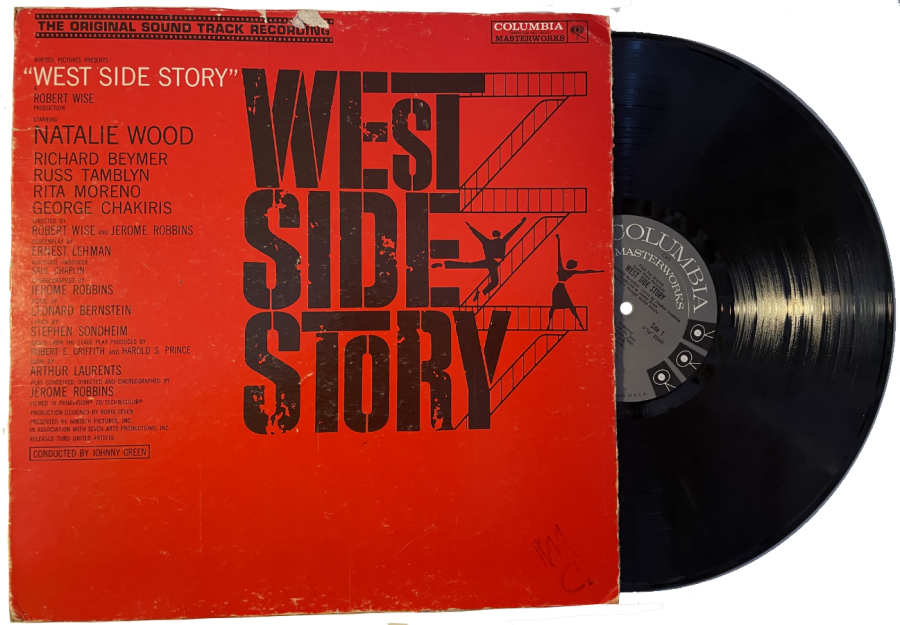“West Side Story” breathes new life into an old story
“Spielberg’s “West Side Story” doesn’t feel as much like a remake as it does a reimagining of the classic tale.”
December 12, 2021
2021 is the year of movie musicals. From the smashing summer hit “In the Heights” to the breakthrough success of “Tick, Tick…Boom!,” we are living in musical theater kid heaven. But the year wouldn’t be complete without the highly-anticipated, seven-years-in-the-making rendition of “West Side Story” from famed director Steven Spielberg.
“West Side Story” is a visually stunning film that comes to life on screen. Spielberg immerses the audience into the world so fluidly and elegantly that it is a shock to learn that this is the first musical he has ever directed. His style and movement matches the rhythm of the songs, all of which are taken directly from the source material. Spielberg’s direction is complemented by Janusz Kaminski’s superb cinematography, whose use of lighting and vibrant colors makes a dazzling experience, as well as the energetic choreography of Justin Peck. It isn’t a stretch to say that “West Side Story” is magical. Scenes like the dance at the gym between the Sharks and the Jets will make you believe in the power of movies again.
Spielberg’s “West Side Story” doesn’t feel as much like a remake as it does a reimagining of the classic tale. Though some have questioned the decision to reinvent what is widely regarded as one of the greatest musical films of all time, the problematic elements of the original make it clear that an update is long overdue. Despite focusing so heavily on Puerto Rican culture, the 1961 version of the film had an almost entirely white cast save for Rita Moreno, who was forced to darken her complexion with makeup. The original movie misses chances for complex discussion of issues like racism by making the conflict at the heart of the story whimsical, if not overly silly. The Puerto Rican characters exist solely as stereotypes rather than real, believable people.
Spielberg’s edition acknowledges and corrects these mistakes. Compared to the original, the movie has a far darker and grittier atmosphere, thanks to its willingness to explore concepts that were only briefly alluded to in the source material. The film doesn’t shy away from raw depictions of violence and bigotry. While it conveys the bright style of the 1950s, the film connects seamlessly to conversations of today’s world.
The screenplay of this adaption fills in missing contextual gaps of the story, fully fleshing out what were once flat characters. The Sharks, the Puerto Rican gang which rivals their white counterparts the Jets, are all portrayed by Latino and Afro-Latino actors. Notably, the casting decisions avoid allegations of colorism that were levied against “In the Heights” earlier this year. Actors flow effortlessly between Spanish and English dialogue. Spielberg declined to subtitle the Spanish in post-production, a decision that communicates the authenticity of the characters. Ariana DeBose gives an absolutely magnetic, stand-out performance as Anita, the bold girlfriend of the Shark’s leader Bernardo. Her captivating, Oscar-worthy performance makes the performance of “America” somehow livelier than its predecessor. DeBose packs an emotional punch that makes up for some of the weaker aspects of the plot.
Class conflict is another focal point of “West Side Story.” The film begins in the backdrop of a rapidly crumbling New York City in the process of gentrification, a far cry from the more staged background of the original. A zoom in on the construction of the Lincoln Center, a project which was responsible for displacing hundreds of immigrant families in the 1950s, gives the movie historical context. The Jets, the white gang that battles against their Puerto Rican counterparts, the Sharks, exist on the low rungs of society. Left in the ruins with drug-addicted, poverty-stricken parents and no chance at success, they turn to one another for relief. They express cruel racism against the other struggling members of the town, namely the Puerto Ricans, because doing so allows them to feel more powerful. Yet as the two groups battle for territory and ownership in the neighborhood, they fail to realize that they are both losers in a larger game run by higher institutions like the police.
The ringleader of the Jets, Riff, played by Mike Faist, is given much more to do this time around. Faist does a perfect job at conveying both the menacing and sympathetic aspects of his role. There is a sense of ever-present tension surrounding his character that enhances his emotional depth and makes the final act of the movie strikingly jarring and resonant.
Unfortunately, strong performances from the supporting cast magnify the weakest aspect of the film, the romance between Tony, played by Ansel Elgort, and Maria, played by newcomer Rachel Zegler. Part of this is a problem of the source material. “West Side Story” is inspired by William Shakespear’s “Romeo and Juliet,” and as such gives a very outdated depiction of the “love at first sight.” Tony and Maria’s romance occurs at the speed of lighting and never gets you fully on board. Elgort’s portrayal feels flat in a movie that is otherwise full of life. Zegler, too, has a tough job in the film. Her character is strictly one-dimensional and overly naive to the detriment of some of the more nuanced aspects of the film.
Even worse than the love at first sight trope is the twist at the end of the third act. To not spoil the movie, though at this point spoilers should come as a given, a theme of forgiveness comes out of left field towards the end of the movie that throws the rest of the plot for a loop. Decisions are made by characters that feel entirely fictional and insulting. While forgiveness is a powerful concept in the real world, it knows no bounds in “West Side Story.” It is a shame that Spielberg didn’t think to change this section of the story when it feels so out of place in his movie.
Though “West Side Story” is not a perfect movie, it manages to be both consistently entertaining and thought-provoking for the duration of its two-hour and 30 minute run time. The world is wild and bright, and it is a pleasure to behold its beauty tonight.








